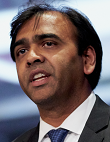Harnessing The Hype: Can AI And Other Tech Make Patients Better Faster?
By Sudip Parikh, Ph.D., senior VP and managing director, DIA Americas

Artificial intelligence (AI), blockchain technology, predictive analytics, cloud computing, and speech and image recognition are the latest buzzwords across industries. Numerous companies are looking to inject these technologies into their operations, and a great deal of funding is pouring into related startups.
The life sciences industry is no exception. Futurists and technology enthusiasts praise the move toward a digital transformation of healthcare and see the potential of these technologies at nearly every point on the healthcare continuum. Not surprisingly, biopharma and tech companies quickly responded to the trend, and even regulatory authorities aren’t lagging far behind. At least one out of every five biopharma companies has a chief digital officer (CDO); various technology companies, including Microsoft, Oracle, IBM, and many smaller firms, are designing new tools for the healthcare sector; and regulatory agencies in different parts of the world are taking steps to incorporate considerations about these technologies in the regulatory process.
Admirable steps, no doubt. But with all these efforts underway, are patients actually getting better faster? Or is our AI enthusiasm simply emulating the Big Data hype that swept across the country only a few years ago, when most companies and their freshly hired data scientists weren’t actually ready for handling massive amounts of data and the technology associated with it?
Laudable Goals, Great Expectations
Expectations related to AI, blockchain, and other tech trends are extremely high. Companies offering AI technologies to the healthcare industry present us with the image of a table richly laid with tools that will upend the status quo, optimizing business decision making, improving clinical and operational effectiveness, and reducing development times.
Healthcare companies and large institutions are turning to technology with the hope of lowering research and development costs and streamlining the workflow from drug discovery to market access. The ultimate goal of this digital uptake is to bring better therapies to market faster.
According to tech leaders, besides cutting costs and reducing trial times by almost half, trained AI models will be used to identify leading compounds in drug discovery, classify volumes of incoming health data in pharmacovigilance, refine experiments over time, and predict disease stages. But for AI to be a true game-changer and successfully permeate the different areas of the healthcare sector, there are two important questions we should ask:
- Are the involved stakeholders truly maximizing the application of digital tools to advance healthcare product development and access to medicines?
- Can AI and other technologies be applied in healthcare in ways that improve patient outcomes? In other words, will patients get better faster because of these technologies?
Realizing The Potential Of AI
Although a generally optimistic outlook is appropriate, patients won’t start to get better faster simply from injecting AI technologies into healthcare whenever and wherever we see a potential for them. Ultimately, the involved stakeholders will have to come together on a unified vision of where and how AI and the other technologies can make a difference, and where they may not add value.
Unfortunately, healthcare – particularly the life sciences sector – remains one of the most fragmented industries, and strategies capable of breaking silos and bridging this fragmentation are difficult to identify, much less to implement. The confluence of three streams of progress seems to be essential to reap the full benefits of AI and other advanced technologies in the life sciences industry:
- Co-development of the rapid advances in AI, blockchain, and other information technologies with the equally rapid advances in healthcare product development technologies and processes;
- A market understanding of what is and is not possible, with investors separating realistic, truly transformative products from empty vessels that have come along for the ride; and
- A regulatory and policy evolution that enables and encourages a vision for the future while protecting patients from the hype.
Converging these streams will lead to the healthcare digital transformation that makes patients better faster and to business models that capture the value of this transformation while ensuring the economic sustainability of healthcare.
How Far Have We Come?
- Industry has taken on numerous projects to optimize individual links in the long chain of processes that lead from drug discovery to market access (here are just a few examples). Although these projects are important, they often fail to connect the links, missing the opportunity to take a big picture look at the entire pharmaceutical tech landscape to maximize the utility of these new technological tools.
- At the organizational level, CDOs, who help an organization go from analog to digital while keeping an eye on the market, have been partially successful. In some companies, CDOs have managed to shift focus away from the shiny new tech tools toward the problems they are supposed to solve, building teams capable of creating important insights and emphasizing initiatives that will achieve company goals. The collective impact on the overall digital transformation of healthcare, however, has so far been modest.
- In the regulatory space, some initiatives are including technological considerations to enable the good and protect against the bad, speeding up the approval process, or improving access and quality of medical treatments for patients. The U.S. Food and Drug Administration, for example, recently launched its Software Pre-Cert Pilot Program, as part of its Digital Health Innovation Action Plan. The program reimagines the regulatory approach for digital health companies that have developed and tested quality products in the past. The Pharmaceuticals and Medical Devices Agency (PMDA) in Japan has incorporated Health Technology Assessments (HTAs) into its health policies, making sure that the social, economic, and ethical issues of new health technologies are properly evaluated. And with its Rational Medicine Initiative, the PMDA will create the medical environment in which new technologies are optimally utilized to treat patients.
We have clearly made significant progress on various fronts. What’s less clear is whether this progress has brought us closer to the confluence of the listed work streams – a holistic understanding of the various factors playing into the successful implementation of AI in healthcare product development. Are we in fact converging on a common set of goals that is centered on the patient, rather than on individual success stories?
What’s Next?
Communication and shared knowledge will have to be next on the horizon of healthcare innovation if we are to bring the technological revolution to full fruition. Neutral organizations that specialize in providing platforms for sharing knowledge across professional boundaries will help leverage context-dependent insights to drive convergence on a common goal.
At DIA, for example, pressing issues and imminent changes associated with the use of AI in the life science industry set the agenda for much of what we do. Topics on the use of AI ranging from discovery to regulatory submittal to pharmacovigilance and commercialization are now making their way into our regional and global conferences, publications, and training programs. Other initiatives are underway as well, including efforts to describe the current pharmaceutical tech landscape in collaboration with research institutions and companies. Ensuring that insights are shared across the healthcare continuum will be the linchpin that drives AI use in the right direction and leads to outcomes that benefit patients.
We are on the verge of a digital revolution in every corner of the healthcare sector, but there are no guarantees that we’ll succeed in the life sciences industry. The most successful stakeholders will be those who understand the full potential as well as the limits of these technologies, integrate smart, patient-centered initiatives at critical points across the pharmaceutical tech landscape, know when to say no to technology, and keep pace with the rapidly evolving patient and business needs.
Although we won’t have optimized the use of healthcare technologies by the end of 2018, we can be quite confident that the myriad efforts currently underway will have brought us closer to the ultimate end goal of making patients better faster with technology.
References:
- https://diapublications.podbean.com/e/blockchain-ai-and-other-radical-drivers-of-biopharmaceutical-innovation/
- https://blog.benchsci.com/pharma-companies-using-artificial-intelligence-in-drug-discovery
- https://www.fda.gov/MedicalDevices/DigitalHealth/DigitalHealthPreCertProgram/Default.htm
- https://www.fda.gov/downloads/MedicalDevices/DigitalHealth/UCM568735.pdf
- https://www.fda.gov/downloads/MedicalDevices/DigitalHealth/UCM568735.pdf
- http://www.globalforum-online.org/April2017/index.html?page=14
 About The Author:
About The Author:
Sudip Parikh serves as senior VP and managing director for DIA Americas. He is an active board member of several health and science policy organizations, including Research America, the Friends of Cancer Research, and the Food Innovation Center.
